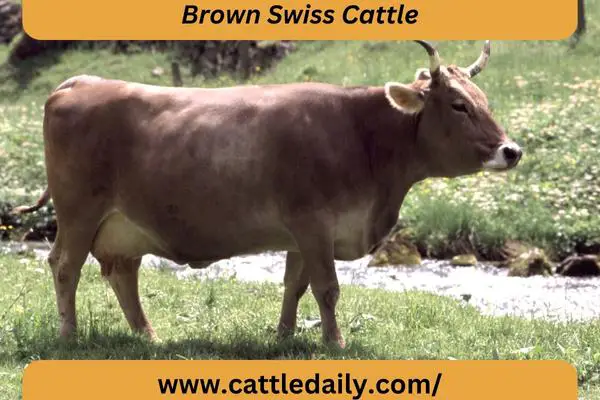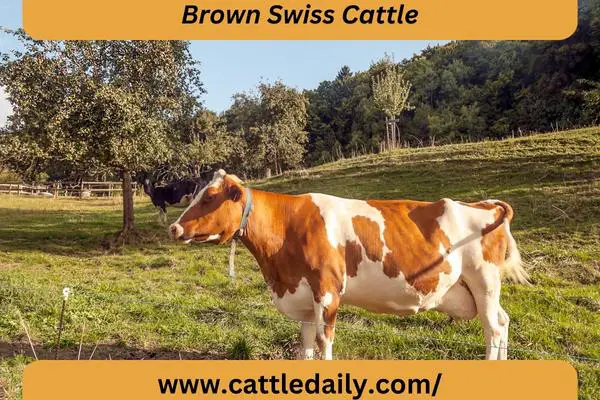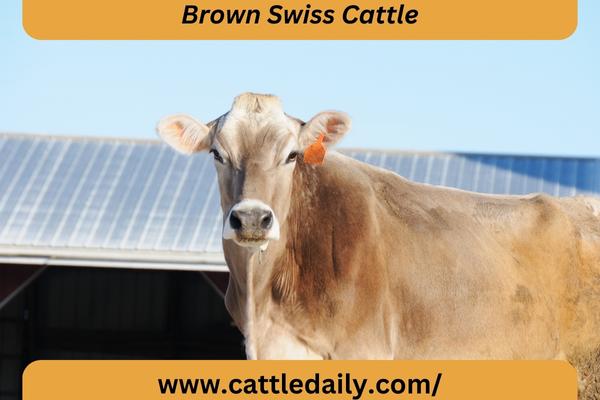Brown Swiss Cattle
The Brown Swiss is one of the oldest cattle breeds, originating from the Swiss Alps. With their distinctive brown coats and muscular bodies, Brown Swiss cattle are dual-purpose animals valued for both milk and meat production.
Origin of Brown Swiss Cattle
The Brown Swiss breed originated in the Schwyz canton of Switzerland, with earliest records dating back to at least 800 AD.
Selective breeding in the isolated mountain valleys led to the development of hardy, sturdy cattle that could thrive in the harsh Alpine climate and utilize marginal forage.
The Roman invasion of Switzerland in 100 BC likely introduced larger framed cattle to the native Swiss stock. Crossbreeding between these Roman cattle and local breeds produced the ancestral population of the modern Brown Swiss. Centuries of natural and artificial selection honed the Brown Swiss into an efficient grazing animal and proficient milk producer.
Brown Swiss cattle spread across the European Alps throughout Switzerland, southern Germany, Austria, and northeastern Italy. In 1869, the first Brown Swiss cattle were imported to the United States, arriving in Belmont County, Ohio. From these initial imports, the breed expanded across America. Today, Brown Swiss are found worldwide in over 50 countries on 6 continents.
Characteristics of Brown Swiss Cattle
The Brown Swiss is a large, muscular cattle breed with a rugged frame adapted for life in the mountains. They have broad heads with a straight facial profile and a wide muzzle. Their eyes are large and set wide apart. Ears are medium-sized, furry, and alert.
Brown Swiss have short, strong legs with dark hooves that resist cracking and splitting. Their necks blend smoothly into deep, broad chests and straight, level toplines. Hindquarters are evenly muscled.
Coats are short and range from silver to dark brown in color, often with lighter coloring on the back, flanks and underside. Distinctive markings include white head spots, white legs, and white tail switches.
Bulls stand around 5 feet tall and can weigh over 2,000 lbs. Cows stand about 4 feet 6 inches tall and weigh around 1,500 lbs. Calves are small at birth to allow for easier calving.

Brown Swiss Use and Products
The Brown Swiss is primarily used for dairy production. Their large frame, wedge-shaped udder, and calm temperament make them well-suited for the milking parlor.
Brown Swiss milk has above average protein (3.5%) and fat (4%) content. Excellent cheese yields are obtained from Brown Swiss milk due to its composition. On average, mature Brown Swiss cows produce over 11,000 lbs of milk per lactation.
Some Brown Swiss are used for meat production as well. Their beef is lean yet finely marbled for great flavor. Brown Swiss dairy crosses are commonly used in Europe for beef. Purebred steers and cull cows are also finished for high-quality beef.
The hides of Brown Swiss produce fine leather due to their thickness and tight grain. The leather is prized for luxury shoes, handbags, furniture, and automotive upholstery.
Advantages of Raising Brown Swiss Cattle
There are many advantages to raising Brown Swiss cattle:
1. High Milk Production
Brown Swiss cattle are excellent milk producers, especially when raised on pasture and forage. Their large frames and wedge-shaped udders allow for high volumes of milk. Mature Brown Swiss cows average over 11,000 pounds of milk per lactation, with top producers giving 25,000 pounds or more.
2. Heat Tolerance
Adapted to the hot summers of the Alps, Brown Swiss are more heat tolerant than the typical Holstein or Jersey. They can maintain higher milk production in warm climates that cause heat stress in other dairy breeds.
3. Calving Ease
Brown Swiss calves have a lower birth weight than other dairy breeds, averaging just 80-85 lbs. Smaller calves lead to faster, easier calvings with lower rates of dystocia (difficult birth).
4. Longevity
With a rugged constitution and excellent fertility, Brown Swiss cows remain productive for many lactations. Average herd life is over 5 lactations, with top producing lifespans of 15 lactations or more.
5. Docility
Brown Swiss are known for having a calm, patient temperament. They are cooperative and easy to handle – important traits for intensive dairy management.
6. Fertility
Brown Swiss bulls maintain excellent fertility even when heavily used for artificial insemination. Cows readily cycle and conceive back after calving.
7. Grazing Ability
This breed makes efficient use of pasture and lower quality forage. Brown Swiss produce well on grass and can meet their nutritional needs solely on pasture.
8. Disease Resistance
Likely a result of hybrid vigor, Brown Swiss show better immunity to common bovine illnesses like mastitis, displaced abomasum, and foot rot.

Disadvantages of Brown Swiss Cattle
1. Lower Protein Percentage
While Brown Swiss milk has decent protein content at 3.5%, it does not have as high of a protein percentage as Holstein milk (3.7%).
2. Large Frame
Mature Brown Swiss cows can be quite large, making them more difficult to handle. Average height is 4 feet 6 inches and weight is around 1500 pounds.
3. Higher Veterinary Costs
Without access to pasture, Brown Swiss are prone to hoof problems like sole ulcers, requiring greater veterinary care.
4. Poor Heat Tolerance
While Brown Swiss handle heat better than some breeds, milk production still declines significantly in hot, humid climates compared to more temperate regions.
5. Slow Maturing
For beef production, Brown Swiss are slower growing and have poorer feed conversion rates compared to specialized beef breeds.
6. Trouble Calving
The large size of calves, especially bulls, may require assistance at birth. Male calves average 90-100 lbs at birth.
7. Less Marbling
Brown Swiss beef is lean with less intramuscular fat. Carcasses grade Select instead of Choice quality, with less desirable marbling.
In summary, Brown Swiss are a hardy, long-lived breed that thrive under a pasture-based management system. Their high milk production and lean, tender beef make them a dual-purpose breed suitable for small farms or large dairy operations.
While Brown Swiss have some disadvantages, their excellent adaptability, longevity and docility make them a worthwhile breed to consider raising. learn here more about cattle breeds and types guide.


